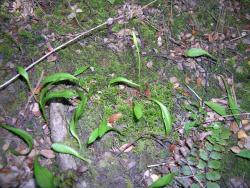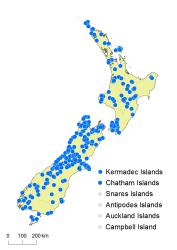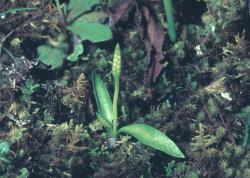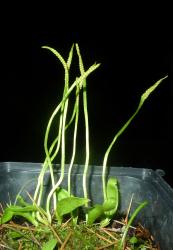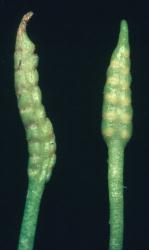- Taxon
- Gallery
- ≡ Ophioglossum lusitanicum subsp. coriaceum (A.Cunn.) R.T.Clausen, Mem. Torrey Bot. Club 19: 161 (1938)
- = Ophioglossum vulgatum var. minimum Hook.f., Bot. Antarct. Voy. II (Fl. Nov.-Zel.) Part II, 50 (1854)
- = Ophioglossum minimum J.B.Armstr., Trans. & Proc. New Zealand Inst. 13: 342 (1881)
Rhizomes erect, subterranean, 2–20 mm long, glabrous; roots fleshy, horizontal ones producing vegetative buds. Fronds 12–200 mm long, rarely up to 250 mm long in wet substrates, divided into a sterile lamina and fertile sporophore. Stipes 1–75 mm long, rarely up to 95 mm long in wet substrates, yellow-brown, glabrous or with very occasional hairs. Sterile laminae (on fertile fronds) undivided or linear or narrowly elliptic or ovate or narrowly obovate or spathulate, 4–70 mm long, rarely up to 110 mm long in wet substrates, 0.5–14 mm wide, rarely up to 20 mm wide in sheltered habitats; apex acute to acuminate or rarely obtuse; margins entire; base attenuate or acuminate, sessile or tapering to an indistinct stalk; both surfaces green or yellow-green; fleshy or herbaceous; glabrous or with very occasional hairs. Veins often obscure. Sporophore usually held above the sterile lamina, borne on a stalk 5–120 mm long, entire, linear or oblong, 3–21 mm long, very rarely up to 27 mm, 1–3.5 mm wide, fleshy, glabrous. Sporangia in 3–17 pairs, very rarely up to 20 pairs, deeply sunken in two rows on either side of the sporophore.
Ophioglossum coriaceum is much more common in New Zealand than O. petiolatum. Although most plants can be distinguished by a combination of characters, there is some overlap in their range of variation. Ophioglossum coriaceum has a generally narrower sterile blade (rarely more than 14 mm wide) that tapers to an attenuate or acuminate base and often has indistinct veins; the length:width ratio is usually more than 3:1. The sporophore is shorter (3–21 mm long) and has fewer sporangia (very rarely more than 17 pairs). By contrast, O. petiolatum has a broader sterile blade (rarely less than 8 mm wide) that is cuneate to truncate at the base and often has distinct veins; the length:width ratio is almost always less than 3:1. The sporophore is generally longer (10–55 mm long) with more sporangia (rarely less than 17 pairs).
Ophioglossum coriaceum is very variable in size and leaf shape but is more consistent with respect to the number of pairs of sporangia in the sporophore. Etiolated plants occur in bogs and wet substrates on the West Coast of the South Island and on the Chatham Islands, and have much longer dimensions than those elsewhere. The extreme sizes given in the description are from such plants, or from plants growing in very sheltered habitats, often at higher altitudes.
Harris (1955) and Large & Braggins (1991) noted differences in the spores of the two species. Ophioglossum coriaceum has smaller spores with larger and more widely spaced pits on the surface, whereas O. petiolatum has larger spores with smaller, closely packed pits, giving an almost micro-papillate appearance. Whilst confirming these observations, Brownsey & Lovis (unpublished results) also found that populations of O. coriaceum with n = c. 360 had larger spores than those with n = 120, but were indistinguishable in other morphological characters.
North Island: Northland, Auckland, Volcanic Plateau, Gisborne, Taranaki, Southern North Island.
South Island: Western Nelson, Sounds-Nelson, Marlborough, Westland, Canterbury, Otago, Southland, Fiordland.
Kermadec Islands, Chatham Islands, Stewart Island.
Altitudinal range: 10–1650 m.
Ophioglossum coriaceum occurs in lowland, montane and subalpine areas throughout the North Island, but is rare in the Coromandel, Bay of Plenty, Gisborne and east coast regions. It extends from near sea level to 1450 m on Mt Hikurangi. It occurs throughout most of the South Island from lowland to subalpine areas, extending locally into the alpine zone. It extends from near sea level in the far south to 1650 m on Mt Arthur, north-west Nelson. The species also occurs on the Kermadec Islands, Chatham Islands and Stewart Island.
The species is treated here as a New Zealand endemic (see below), but very similar forms occur in Australia, South America and Europe.
Occurs in forest and open mānuka scrub, in bush clearings and on bush margins, but more frequently in open areas and sometimes in thermal areas. It is found on dunes, in wet hollows, salt meadow and grassland, on grassy and mossy banks, in short turf vegetation, herbfield, on lake and tarn margins, on peat and Sphagnum in boggy areas, on tracksides, streambanks, river flats and river beds, on gravel, shingle or scoria, in open tussock, on scree and rock, on pākihi, around sinkholes and near waterfalls or in seepages on rock faces. It occurs more frequently in damper areas. The plant often dies down completely in winter, emerging again in spring from the underground rhizome.
n = 120 (Brownsey & Lovis in Dawson et al. 2000); n = c. 360 (Brownlie 1958). Lovis (in Dawson et al. 2000) reported several populations from Canterbury with 350–360 univalents, suggesting that they were probably apomictic. Counts of n = 120 have been reported from numerous populations in both main islands.
The correct name for this taxon in New Zealand is unclear. It was first described as a distinct species by Cunningham (1837), but Clausen (1938) reduced all South American, Australian and New Zealand material to a subspecies of the northern hemisphere O. lusitanicum. Subsequently Marticorena & Rodríguez (1995) and Chinnock (1998) treated southern hemisphere material as O. lusitanicum. Chromosome counts of n = 120 for some populations of the species in New Zealand (see Dawson et al. 2000) are consistent with the count of n = 125–130 for European material (Manton 1950). However, polyploid counts have also been recorded in this species complex, some of them possibly apomictic. Ninan (1956, 1958) reported n = 240 in Indian plants, Brownlie (1958) and Lovis (in Dawson et al. 2000) recorded n = c. 360 in New Zealand plants, and Verma (1957) reported n = 510 in the only Australian plant counted. Clearly this species aggregate is cytologically complex, and the relationship between plants of different ploidy unresolved. The name O. coriaceum, based on a New Zealand type, is conservatively retained here for the New Zealand taxon until the taxonomy of Ophioglossum is more fully resolved.
The names O. lusitanicum L. and O. vulgatum var. lusitanicum Hook.f. have been widely used by New Zealand authors for O. coriaceum. The names O. vulgatum var. gramineum (Willd.) Hook.f. and O. gramineum Willd. have also been applied to New Zealand material (Hooker 1854–1855; Armstrong 1881a), but these are also probably misidentifications of O. coriaceum.



